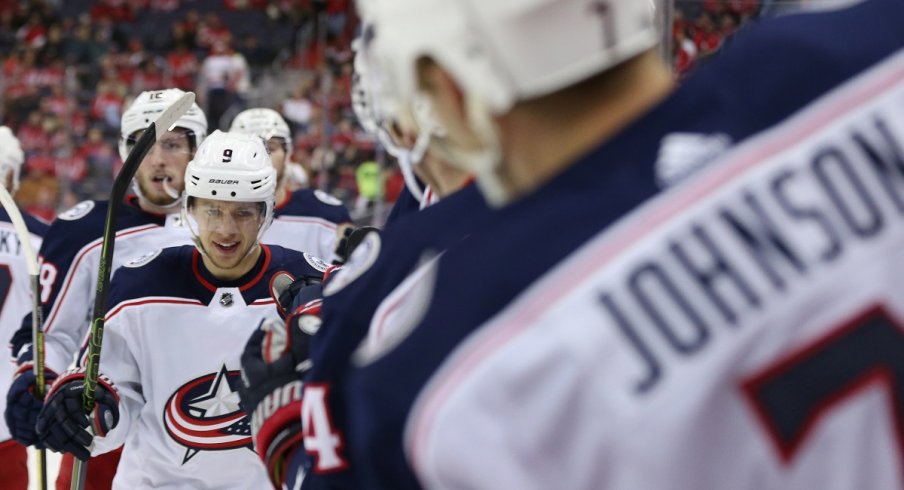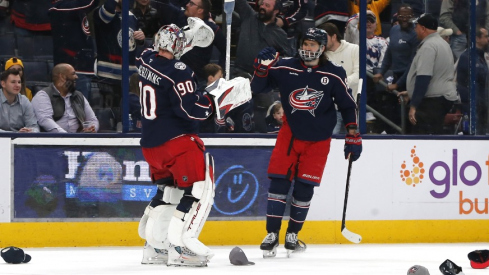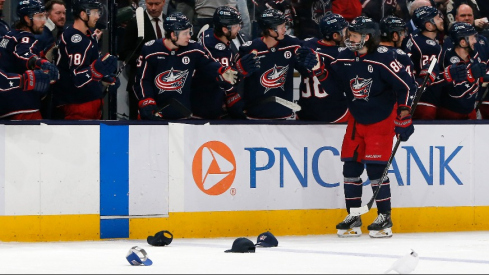It's become one of those online meme things, so to speak, and not just the proper way to pronounce GIF (it's with a soft G, and I will fight over it).
Are the Blue Jackets good?
It's the kind of thing that happens when, well, you're bad for most of your life span. When you then become good, some people have a hard time believing it, whether in a real way or a jocular sort of way.
See Jeremy Crowe's work on Real Legit Wins. Or this website's twitter feed. The CBJ? Good? Is it possible? Is it real?
Well, watching the Jackets over the past few weeks, I've had a very distinct question about this team.
Are the Blue Jackets good?
As I wrote in Monday's look at the Metropolitan Division, it seems like they are. Even after a two-game losing streak, the team is 17-10-1 through 28 games, which is on its face good. The goal differential of plus-8 is tied for second in what is again turning into the NHL's best division. Also good. On Corsica Hockey, the Jackets are projected to finish second in the Eastern Conference and atop the Metro in points, which would be super good.
Puck possession numbers also suggest the Jackets are good. At 5-on-5, the team has been as good as any in the NHL, with 52.81 percent of shot attempts throughout the season at even strength and 57.28 percent of the goals in that state. That's good. All in all, the macro view shows the Jackets well on pace to make the playoffs for consecutive seasons for the first time in franchise history.
In fact, you could argue the only thing truly missing from the team is an elite power play. We all know it's bad, but it's hard to wrap your mind around just how bad it is; the success rate of 8.6 percent is almost eight points lower than the No. 29-ranked team, Chicago. With even a league-average power play, the Jackets would have eight more goals, be outscoring teams 88-70 on the season and probably be running away with the Metro.
I'm not smart enough to point out exactly what is wrong, and everyone has their theory, but it's clear the confidence of the units is near zero and has been for pretty much the entirety of the calendar year. Teams can sense it and have played aggressively against the Jackets, taking away time and space with the confidence that it can disrupt what the CBJ is doing. Good power plays generally use passing and quick shots, then rebounds, to take advantage of having the extra person. Instead, the Jackets are often passing without an end, rushing shots, and even struggling to get the puck into the zone.
But I don't want to get too far down that train. And in fact, many would argue the power-play struggles should even out over time, and again, even giving the CBJ an average power play would, when combined with its dominance at 5-on-5, make the team among the toughest in the NHL to beat.
Going back to the original premise here, are the CBJ good, there are a few things about team personnel right now that are both exciting and concerning.
First, the emergence of the Panarin-Dubois-Anderson line has been fun to watch. Call it the French Bread line, the PB&J line or whatever you like, the unit simply marauds its way through the offensive zone, overwhelming foes with speed, skill and compete level. In more than 100 minutes together at 5-on-5, the trio has a CF% of 68.93 and a scoring chance percentage of 64.86. It's ridiculously good.
Then there's the defensive pair of Seth Jones and Zach Werenski, which has a CF% of 57.95 and a scoring chance percentage of 55.73. Without those two on the ice, the team's CF% at 5-on-5 is 50.13, and its scoring chance percentage is 51.10. Impressive out of one of the youngest and now best defensive pairs in the league.
Have a line and a defensive pair like that and you can have average players around it and be a contender. But as our Dan Dukart pointed out after last night's game, there are concerns around some other parts of the squad, especially the defense. David Savard and Jack Johnson, somewhat out of nowhere, became a shutdown pair a season ago; this year, they've been about average (48.25 CF% at 5-on-5, being outscored 21-18, and their work in transition last night was not exactly stellar) and Savard was even a healthy scratch at one point. They are a clear third defensive pair on the team at this point after the impressive work of the now-injured-but-improving pairing of Ryan Murray and Markus Nutivaara.
But another thing has me a bit worried about this team, but you could call it the kind of thing that is the other side of the unsustainably bad power play – and unsustainably good overtime and shootout record.
Of course, you're never going to apologize for such a thing, and the Jackets have been so good in the extra time because of an elite goaltender and the kind of offensive talent that excels at 3-on-3. Yet expecting a squad to keep an 8-1 record going once you pass 60 minutes is usually a bit of folly.
So where are we now? There's a lot to like about the Blue Jackets. There's one of the best goaltenders in hockey, one whose excellence has become so assumed I didn't even feel like I had to mention in this piece. A number of players are proving exactly how elite they are, and I think such players as Nick Foligno and Cam Atkinson will up their scoring production – perhaps on the power play – to help an offense that hasn't exactly soared thus far.
But there's also enough to make me worry. No team is ever perfect, but the struggles on the power play and in the production of some of the team's veterans remains a concern.
On the whole, though, for right now, I think it's safe to say the Blue Jackets are good.


